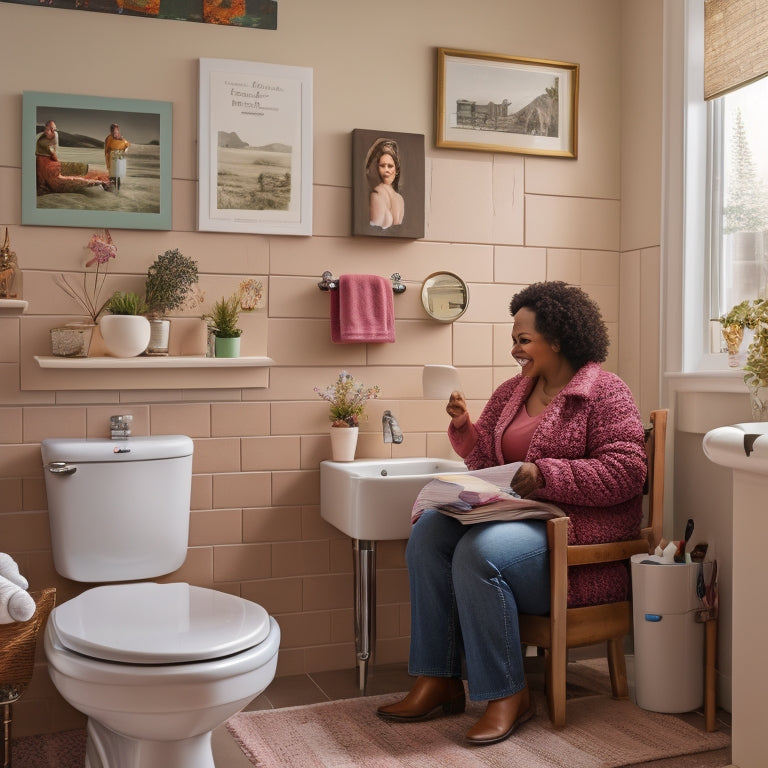
Mastering Toilet Training for Individuals With IDD
Share
Individuals with intellectual and developmental disabilities (IDD) often face unique and complex challenges in achieving independence in toileting, which can have a profound impact on their overall well-being and social integration. Effective toilet training requires evidence-based strategies tailored to unique challenges, such as behavioral approaches like positive reinforcement and visual supports. A thorough assessment of strengths, weaknesses, and motivations is crucial for developing a personalized training plan that considers individual characteristics, preferences, and learning styles. By combining approaches and addressing underlying sensory issues, individuals with IDD can overcome common obstacles and achieve success in toilet training.
Key Takeaways
• Individuals with IDD require personalized toilet training plans addressing their unique challenges, sensory sensitivities, and communication needs.
• Evidence-based strategies like positive reinforcement, visual supports, and data collection are crucial for successful toilet training.
• A thorough assessment of strengths, weaknesses, and motivations is essential for developing a tailored toilet training plan.
• Addressing underlying sensory issues and establishing a consistent routine can help overcome common obstacles and barriers in toilet training.
• Collaboration between caregivers and parents, along with expert insights and real-world applications, can enhance success rates in toilet training for individuals with IDD.
Understanding Toilet Training Challenges
Children with autism and intellectual disabilities often face significant challenges in achieving independence in toileting. This can lead to increased anxiety, social stigma, and decreased opportunities for social integration and academic success. These challenges can be attributed to various factors, including behavioral interventions that may not adequately address sensory sensitivities and communication strategies that fail to accommodate individual needs.
For instance, some individuals may experience discomfort or distress in response to certain toilet textures or sounds, while others may struggle to understand or communicate their needs effectively. By recognizing and addressing these challenges, caregivers and professionals can develop targeted strategies that incorporate reinforcement techniques and tailored communication approaches to support successful toilet training.
Evidence-Based Strategies for Success
Effective toilet training for individuals with autism and intellectual disabilities requires a vital approach that incorporates evidence-based strategies, tailored to address unique challenges and promote successful outcomes.
Behavioral approaches, such as positive reinforcement and visual supports, can be highly effective in toilet training.
Data collection is an essential component of these strategies, allowing caregivers to monitor progress, identify areas for improvement, and make data-driven decisions.
By combining these approaches, individuals with IDD can overcome common obstacles and achieve independence in toilet training.
A thorough understanding of these evidence-based strategies is essential for caregivers and professionals seeking to support individuals with IDD in mastering this critical life skill.
Creating a Personalized Training Plan
An individualized approach to toilet training is essential for individuals with IDD, as each person's unique needs and challenges require a personalized training plan that takes into account their individual characteristics, preferences, and learning styles.
A thorough assessment of the individual's strengths, weaknesses, and motivations is vital in developing a tailored plan. This involves identifying specific goals, objectives, and timelines that are realistic and achievable.
Targeted interventions, such as visual aids, reinforcement strategies, and adapted toilet training equipment, can be incorporated to address specific challenges.
Overcoming Common Obstacles and Barriers
Several common obstacles and barriers can hinder the toilet training process for individuals with IDD, including resistance to change, sensory sensitivities, and inadequate support systems. These challenges can lead to frustration and setbacks for both the individual and their caregivers.
To overcome these obstacles, it is essential to employ targeted behavioral interventions and involve parents in the training process. This collaborative approach can help address individual needs and develop effective strategies for success.
-
Identify and address underlying sensory issues that may be contributing to toilet training difficulties
-
Develop a consistent and predictable routine to minimize anxiety and resistance to change
-
Foster open communication and collaboration between caregivers and parents to establish a unified approach
Expert Insights and Real-World Applications
Incorporating expert insights and real-world applications into toilet training programs for individuals with IDD can greatly enhance success rates and improve overall well-being. By combining clinical perspectives with practical tips, caregivers can create tailored approaches that address unique needs and challenges.
Dr. Rhonda Davin, Dr. Rachel Cagliani, and Kimberly Workman, contributors to this course, emphasize the importance of evidence-based practices in toilet training. They provide case examples, such as Arthur and Andrea, to illustrate effective individualization and implementation strategies.
Frequently Asked Questions
Can Family Members Assist in Toilet Training for Better Outcomes?
Family members can play a crucial role in toilet training, leveraging their unique understanding of the individual's needs and abilities to foster a supportive environment, promoting consistency and collaboration in caregiver roles, and managing complex family dynamics to achieve better outcomes.
Are There Specific Toilet Training Techniques for Non-Verbal Individuals?
Fascinatingly, research highlights the significance of adapting toilet training techniques for non-verbal individuals. Visual Cues, such as pictures or icons, and Gesture Imitation, like mimicking hand gestures, can be particularly effective in facilitating communication and promoting successful toilet training outcomes.
How Do I Handle Regression in Toilet Training Due to Changes in Routine?
When handling regression in toilet training due to changes in routine, identify environmental triggers and adapt to increased routine flexibility by gradually introducing changes, providing visual schedules, and offering emotional support to mitigate anxiety and promote successful adaptations.
Are There Any Toilet Training Apps or Digital Tools That Are Effective?
Several toilet training apps and digital tools have proven effective, offering features like personalized reminders and visual timers to support consistent routines and independence. These tools can be especially helpful for individuals with IDD, providing a sense of control and autonomy.
Can Toilet Training Be Implemented in a Group Home Setting Successfully?
In a group home setting, toilet training can be successfully implemented by ensuring adequate staff ratios, making environmental adaptations such as visual schedules and adapted bathroom facilities, and providing individualized support to meet each resident's unique needs.
Related Posts
-

Contemporary Slimline Storage for Modern Bathrooms
As you envision your modern bathroom, consider the innovative potential of contemporary slimline storage. By cleverly...
-

Revamp Your Bathroom Drawers With Custom Organizer
I'm revamping my cluttered bathroom drawers with a custom organizer that's both functional and visually appealing. I ...
-

DIY Hanging Baskets: Stitch, Store, Admire
To craft a DIY hanging basket, precision is key. Begin by cutting four fat quarters of fabric into rectangles and tab...


